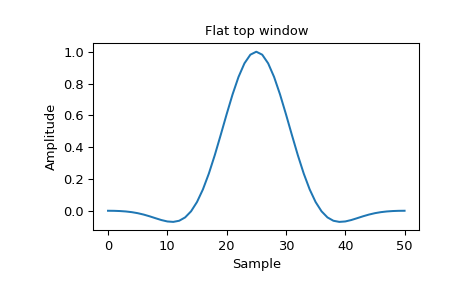scipy.signal.windows.flattop¶
-
scipy.signal.windows.flattop(M, sym=True)[source]¶ Return a flat top window.
- Parameters
- Mint
Number of points in the output window. If zero or less, an empty array is returned.
- symbool, optional
When True (default), generates a symmetric window, for use in filter design. When False, generates a periodic window, for use in spectral analysis.
- Returns
- wndarray
The window, with the maximum value normalized to 1 (though the value 1 does not appear if M is even and sym is True).
Notes
Flat top windows are used for taking accurate measurements of signal amplitude in the frequency domain, with minimal scalloping error from the center of a frequency bin to its edges, compared to others. This is a 5th-order cosine window, with the 5 terms optimized to make the main lobe maximally flat. [1]
References
- 1
D’Antona, Gabriele, and A. Ferrero, “Digital Signal Processing for Measurement Systems”, Springer Media, 2006, p. 70 DOI:10.1007/0-387-28666-7.
Examples
Plot the window and its frequency response:
>>> from scipy import signal >>> from scipy.fft import fft, fftshift >>> import matplotlib.pyplot as plt
>>> window = signal.flattop(51) >>> plt.plot(window) >>> plt.title("Flat top window") >>> plt.ylabel("Amplitude") >>> plt.xlabel("Sample")
>>> plt.figure() >>> A = fft(window, 2048) / (len(window)/2.0) >>> freq = np.linspace(-0.5, 0.5, len(A)) >>> response = 20 * np.log10(np.abs(fftshift(A / abs(A).max()))) >>> plt.plot(freq, response) >>> plt.axis([-0.5, 0.5, -120, 0]) >>> plt.title("Frequency response of the flat top window") >>> plt.ylabel("Normalized magnitude [dB]") >>> plt.xlabel("Normalized frequency [cycles per sample]")


